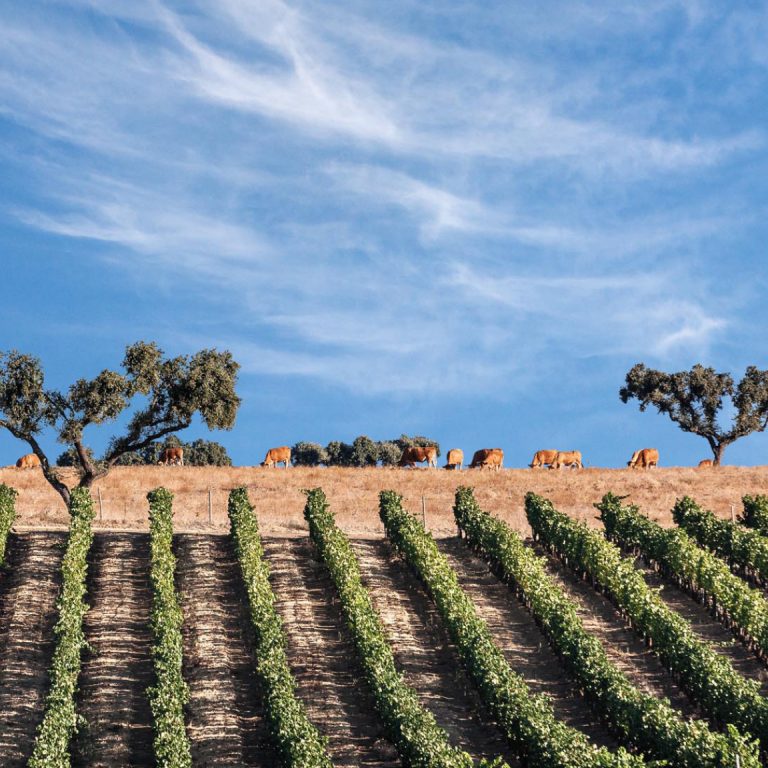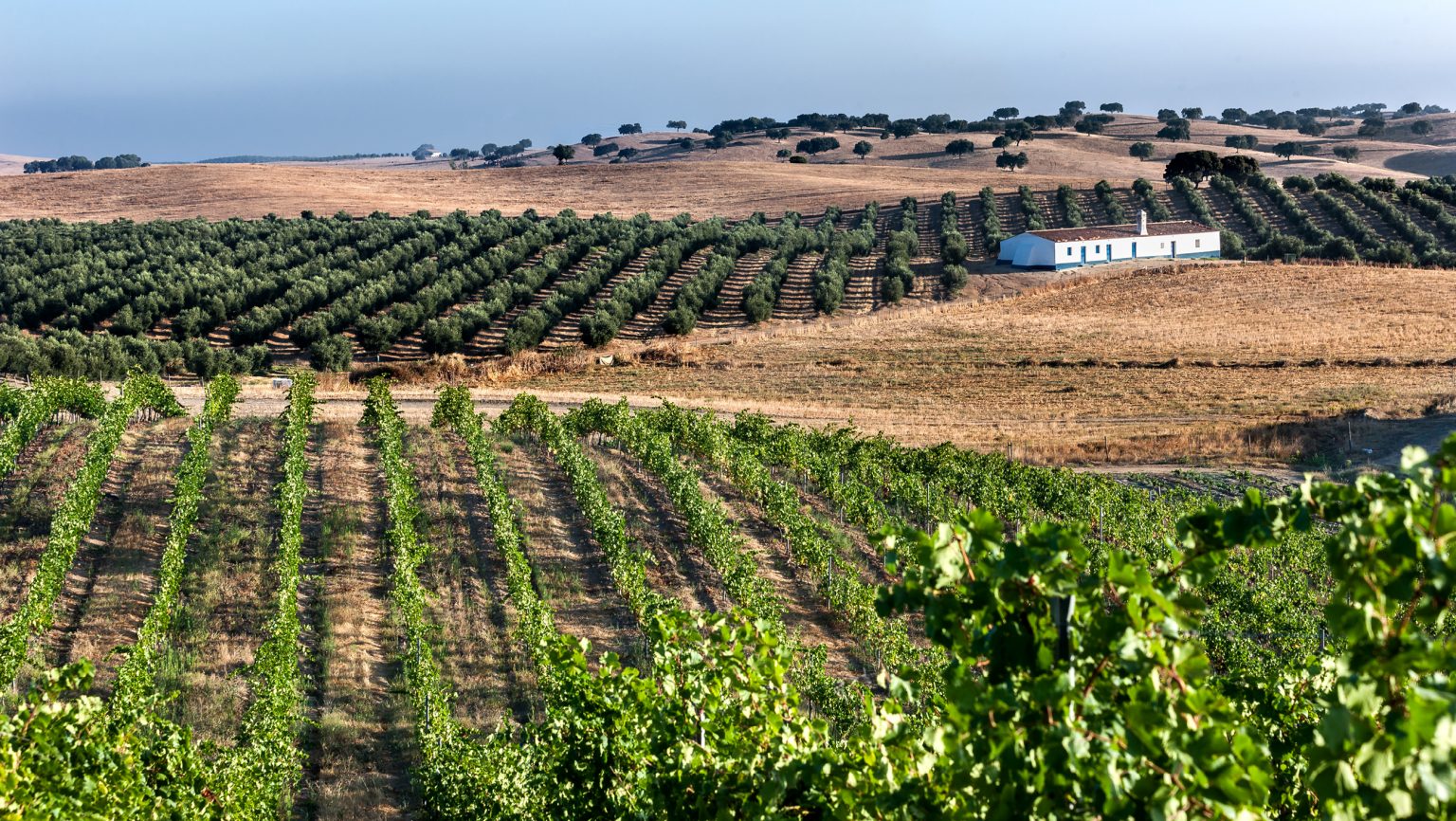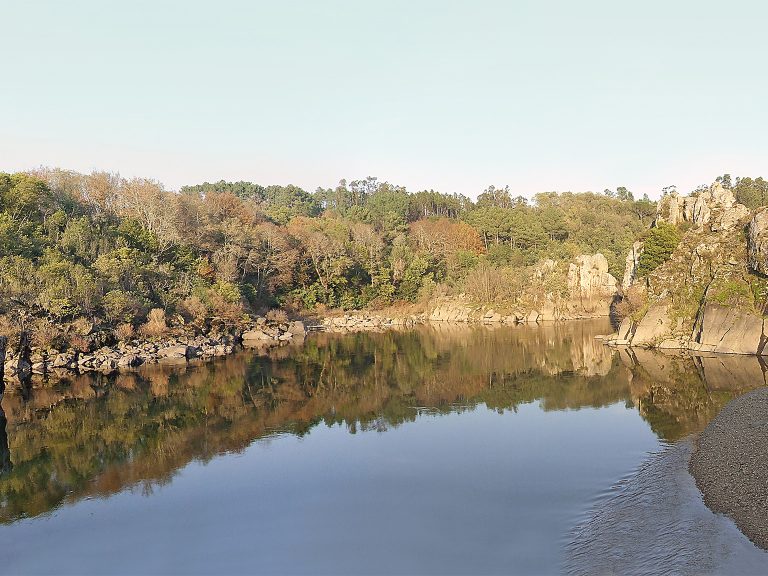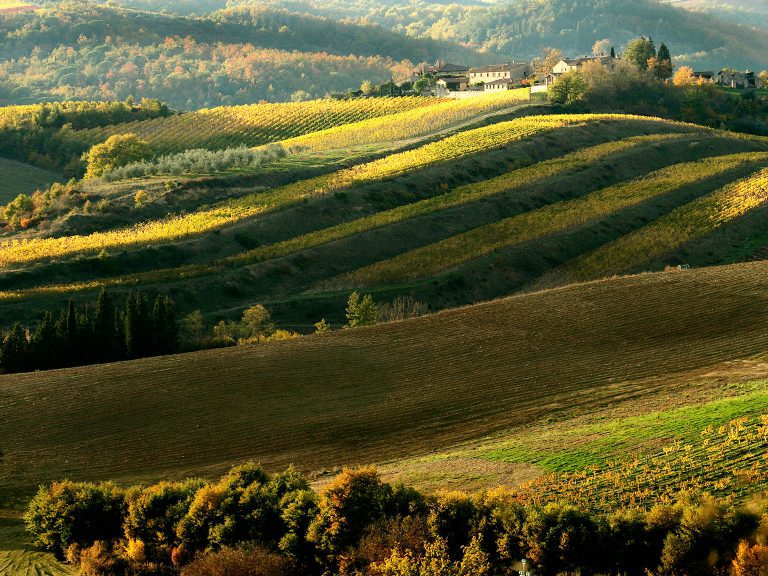This advertising content was produced in collaboration with our sponsor; it does not necessarily reflect the views of SevenFifty Daily’s editorial team. For more information, please refer to our ethics guidelines.
Located in southern Portugal, the region of Alentejo is bordered by Beira Baixa to the north, Spain to the east, the Algarve to the south, and the Atlantic and two other Portuguese regions to the west. It occupies more than a third of continental Portugal and has a long history as a major producer of grains and cork. Even today, nearly half of the world’s supply of corks is cultivated from the region’s cork oak trees. Its wines, however, have lately taken center stage.
Alentejo really began coming into its own as a wine region in the 1980s, when financial assistance from the European Union enabled a number of cooperative producers to focus on upgrading the quality of their wines. Also, starting in the mid-1990s, the number of privately held wine estates began to increase significantly—from 45 to 260 between 1995 and 2010. By 2010, Alentejo had taken over the domestic market’s largest share of quality wines.
In 2014, exports of Alentejo wines outside the European Union accounted for approximately 14 percent of the region’s total production. In 2016, exports to the U.S.—Alentejo’s third largest export market—amounted to 1,719 gallons of wine; in 2017, Alentejo exported 1,639 gallons to the U.S. Today, there are 263 producers in the region, as well as 97 merchants who purchase wine from local producers for their own label bottlings. Most of these businesses are owned and operated by families.

Don’t miss the latest drinks industry news and insights. Sign up for our award-winning newsletters and get insider intel, resources, and trends delivered to your inbox every week.
There are just over 20,000 hectares of vines planted in Alentejo’s soils, which range from granite and limestone to marble and schist. The landscape is typically Mediterranean. The climate is continental, with a long, hot growing season and sunny weather that’s tempered by dry breezes and cool nights.
Favorable climatic conditions and heightened environmental awareness have helped make sustainable farming efforts a priority in the region—efforts encouraged by the Alentejo Regional Wine Growing Commission (CVRA), which has created a formalized wine sustainability program known as the Wines of Alentejo Sustainability Programme, or WASP.

Geography
Alentejo comprises about 27,272 square kilometers, with approximately 20,670 hectares under vine. The landscape features gently undulating plains, which periodically give way to sprawling vineyards, forests of native cork and holm oak trees, and olive groves.
Alentejo’s relative flatness and consequent lack of physical barriers to block the condensation of humidity coming from the ocean minimizes the Atlantic’s influence in the region. But Alentejo’s few ranges of hills and mountains have a significant influence on the diverse growing conditions in each of its subregions.
The continental climate is characterized by low rainfall; long, cold winters; and hot, dry summers. Irrigation is permitted. Springtime brings a risk of frost. The region’s vines have traditionally been bush trained, but it’s common for new plantings to be wire trained to allow for mechanized harvesting.
The region’s heterogeneous soil types are scattered with outcrops of clay, schist, granite, gravel, marble, and limestone. The main soil types are:
- Nonhumic granitic litholic soils
- Mediterranean quartz diorite derived grayish soils
- Mediterranean schist or graywacke derived grayish soils
- Mediterranean red or yellowish soils derived from Rañas or from similar deposits
- Red calcareous soils
- Mediterranean red or yellow schist derived soils
History
The history of Alentejo is a turbulent one. The region has seen alternating periods of vigor and decline, war and peace. With regard to wine, there are many archaeological finds that suggest wine was already part of daily life in the area by the time the Romans arrived.
With their farming expertise, the Romans helped further cultivate the local vineyards and cemented winemaking as a mainstay of the Alentejo lifestyle. Roman influence was so critical in the development of Alentejo viticulture that even today, after more than 2,000 years, signs of Roman civilization are apparent in winemaking tasks, such as fermenting the must and storing wine in talhas de barro, or clay vessels—some of which weigh up to a ton and have the capacity to hold 2,000 liters of wine.
When the Moors invaded the Iberian Peninsula at the beginning of the 8th century, the introduction of Islamic culture led to a gradual decline of winemaking in the Alentejo—the Moors remained in power until 1165. By the 16th century, wine began to flourish again in places like Évora and Beja, as well as in Alvito, Viana, and Vila de Frades, where the blending of red and white wines together was a popular style of the time.
During the 17th century, Alentejo wines—along with those from Beira and Estremadura—became the most renowned among Portuguese wines. But war and other political influences put an end to the wine region’s success. It wasn’t until after the French invasion of Portugal that wine culture returned to the Alentejo, with the blessing of the royal family and the new religious orders. In the mid-19th century, there was a campaign to reinstate agriculture in the region, and a new generation of farmers revived the vineyards.
Another downturn occurred in Alentejo wine cultivation when phylloxera hit vineyards in the late 1800s. The louse epidemic, followed by two world wars, a series of economic crises, and a campaign to cultivate grains instead of vines, led to another decline in winemaking. The region’s wine industry didn’t begin to recover until the end of the 1940s.
The first appellations in Alentejo were designated in 1988, and the CVRA was founded in 1989 as a private institution dedicated to certifying, controlling, and protecting all Alentejo wines.

The Appellations
There are two types of appellations in Alentejo. One is the more stringent designation of origin (PDO); the other is a less strict geographical designation (PGI).
Alentejo’s protected PDO appellation comprises eight subregions:
- Borba
- Évora
- Granja-Amareleja
- Moura
- Portalegre
- Redondo
- Reguengos
- Vidigueira
The total approved PDO vineyard area is approximately 11,763 hectares. The remaining vineyard area for the PGI denomination is approximately 6,233 hectares. Producers making wine under the PGI classification—those whose vineyards lie outside the eight denominated subregions, as well as numerous well-known winemakers within the PDO areas—have greater autonomy in their choice of viticulture and viniculture practices and grape varieties. They are allowed to grow some non-Portuguese varieties alongside traditional Alentejo varieties.
The Vinho Regional Alentejano PGI is divided into three administrative districts:
- Portalegre
- Évora
- Beja
The average production in the overall Alentejo region is 7,625 kilograms per hectare. All producers in the region seeking PDO or PGI designation must obtain certification of their products by the CVRA. This can be done for these categories of products: white, red, and rosé wines, fortified wines, sparkling wines, pomace-based spirits, and grape-based spirits.
The aging requirements for Alentejo wines are:
- White or Rosè Reserva—6 months
- White Grande Reserva—12 months
- White Garrafeira—12 months, with a minimum of 6 months in bottle
- Red Reserva—12 months
- Red Grande Reserva—24 months
- Red Garrafeira—30 months, with a minimum of 12 months in bottle
Key Grape Varieties
Many indigenous grape varieties are cultivated in the Alentejo, each of which contributes to distinctive characteristics of the wines. A number of nonindigenous grapes have also been introduced in recent years; they’ve added new flavors and greater value to the local blends and helped solidify Alentejo’s reputation as a leading winegrowing region. Nearly 80 percent of Alentejo’s wine is made from red varieties. Just under 20 percent is made from white grapes (less than 2 percent of the production is rosé wine).
Red Varieties
Alfrocheiro
Native to the Dão region, this fertile grape variety is becoming increasingly popular in Alentejo. Alfrocheiro yields richly colored wines that achieve good balance between warming alcohol, fine-grained tannins, and crisp acidity. The grape gives dominant notes of blackberry and ripe wild strawberry and adds structure to Alentejo’s blends.
Alicante Bouschet
Deeply rooted in the Alentejo winemaking tradition, this red-fleshed teinturier grape variety is often assumed to be a native species; it hails, however, from France. Alicante Bouschet produces soft, fruity wines with deep color, good structure, and firm tannins. In blends, it boosts color, vigor, and volume, expressing aromas of forest fruit, cocoa, and olives, as well as vegetal notes.
Aragonez
Most likely a native of Rioja, where it’s known as Tempranillo, Aragonez is an early-ripening grape. It produces wines with a relatively low level of acidity. In the Alentejo, it’s commonly blended with Trincadeira and Alicante Bouschet.
Cabernet Sauvignon
This international variety reveals a particular style in the Alentejo, where it can ripen to perfection. Though only small amounts are used, Cabernet Sauvignon adds concentrated color, spice, body, and consistency to the local blends, resulting in wines that are well-balanced, aromatic, fruity, and spicy. It’s rarely bottled as a single-varietal wine in Alentejo.
Castelão
For years, Castelão was the most widely planted grape in Portugal, including in the Alentejo, but these days plantings are in decline. However, when Castelão is cultivated in carefully controlled mature vineyards, where yields are deliberately kept low, it can produce well-structured, fruity wines with mouthwatering acidity and prominent tannins. This grape typically displays notes of currants, preserved plums, wild berries, and hints of game. High-quality Castelão wines have excellent aging potential.
Syrah
This nonindigenous variety has adapted extremely successfully to the diverse climate of the Alentejo. It yields full-bodied, fruity, spicy wines that can be enjoyed young but also have the potential to age. Syrah is seldomly bottled as a single-varietal Alentejo wine. Rather, small amounts are used in many of the region’s most prestigious blended wines.
Touriga Nacional
Touriga Nacional is the most renowned Portuguese grape in Portugal—and elsewhere. It has a long history in the Dão and Douro regions of the north, both of which claim it as their own indigenous variety. It’s a thick-skinned grape that in the Alentejo is often blended with other varieties. Blends made with Touriga Nacional have intense fruit and floral aromas, sometimes with hints of citrus, and they tend to be powerful, with concentrated color.
Trincadeira
A temperamental variety, Trincadeira thrives in subregions of the Alentejo that have poor soil and a hot, dry climate. It produces irregular and unpredictable high yields. Its wines are aromatic and fruity, often with hints of floral and vegetal notes. It has traditionally been blended with the Aragonez grape and has proved indispensable to many Alentejo blends.
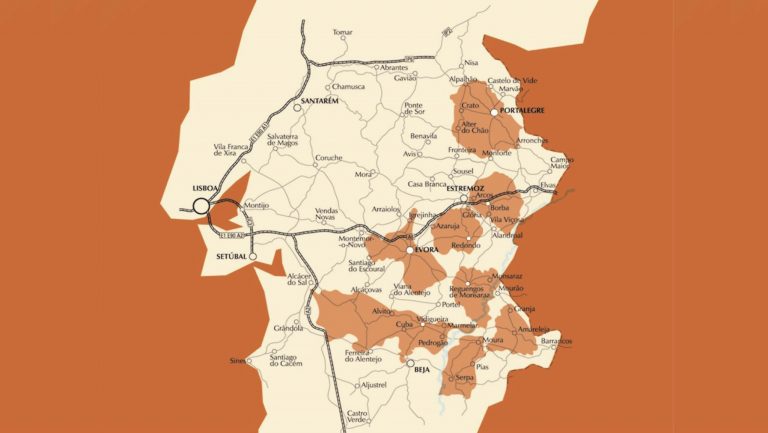
White Varieties
Antão Vaz
Considered the most important of Alentejo’s white varieties, the Antão Vaz grape produces consistently high yields. Its wines are full-bodied, aromatic, and firmly structured. The longer Antão Vaz grapes are left on the vine, the higher the alcohol content. Unless the grapes are harvested early, the wines tend to have low levels of acidity. Antão Vaz is often blended with Roupeiro and Arinto, both of which boost the acidity of blends. Antão Vaz wines are often aged in new oak barrels, and they’re frequently bottled as single varietals. Common aromas include tropical fruits and tangerine peel, and the wine features subtle minerality.
Arinto
Due to its versatility, Arinto has become a popular domestic grape for blending. It produces crisp, vibrant wines with high natural acidity and bracing minerality. These wines also have strong potential for aging. This grape adds freshness and acidity to the blends of the region. Although aromatically restrained, with little exuberance or intensity of its own, it imparts subtle aromas of green apple, lemon, and lime, and sometimes passion fruit, alongside a vegetal and mineral character, which at times can be quite pungent. Arinto benefits from extensive maceration and a long fermentation at low temperature; it can be further enhanced by barrel fermentation.
Fernão Pires
The most widely planted white grape variety in Portugal, Fernão Pires has gradually taken a strong hold in the Alentejo. It’s a high-yielding, versatile grape with fragrant aromas of lime, lemon, lemongrass, lime-tree blossom, basil, roses, tangerines, and orange blossom. It can be low in acidity, and sometimes the variety is subject to early oxidation. Fernão Pires wines are best enjoyed in their youth, when their flavors are still vibrant.
Gouveio
A vigorous variety that ripens early and offers medium yields, Gouveio has been rapidly and widely adopted throughout the Alentejo. Its wines tend to be creamy and full-bodied, with high alcohol with firm acidity. Telltale notes include citrus, apple, peach, and anise. The wines have good aging potential.
Roupeiro
Fragrant with notes of orange, lemon, peach, melon, bay leaf, and wildflowers, Roupeiro tends to lose its initial aromatic intensity fairly quickly, leading to wines that become neutral in the bottle after some months.
What’s Happening in Alentejo Today?
The most significant new development in the region is the Wines of Alentejo Sustainability Programme, or WASP, which is designed to support the environmental, social, and economic performance of winemaking activities in the region. It aims to promote sustainable winemaking and to affirm the Alentejo brand and make it more competitive in internal and external markets.
Serving as a catalyst for stimulating research and eco-innovation, WASP fosters an innovative, conservation-minded approach to grape and wine production. Additionally, it provides training and education on sustainability best practices for growers and producers.
Members are asked to complete a self-assessment for 11 primary intervention chapters, developed with 108 criteria, to establish an overall ranking in a “general sustainability” category. The assessment focuses on topics such as grape production, water conservation, and management of soil, water, diseases, pests, and waste. This ranking then falls within one of four statuses (pre-initial, initial, intermediate, and developed).
WASP currently numbers 156 members. These members are associated with 5,049 hectares of vines and 58 million liters of PDO and PGI wine annually. The ultimate goal for every member is to keep working toward improved sustainability until the general sustainability status of “developed” is achieved, earning the member third-party validation and formal recognition of sustainability for their production.

